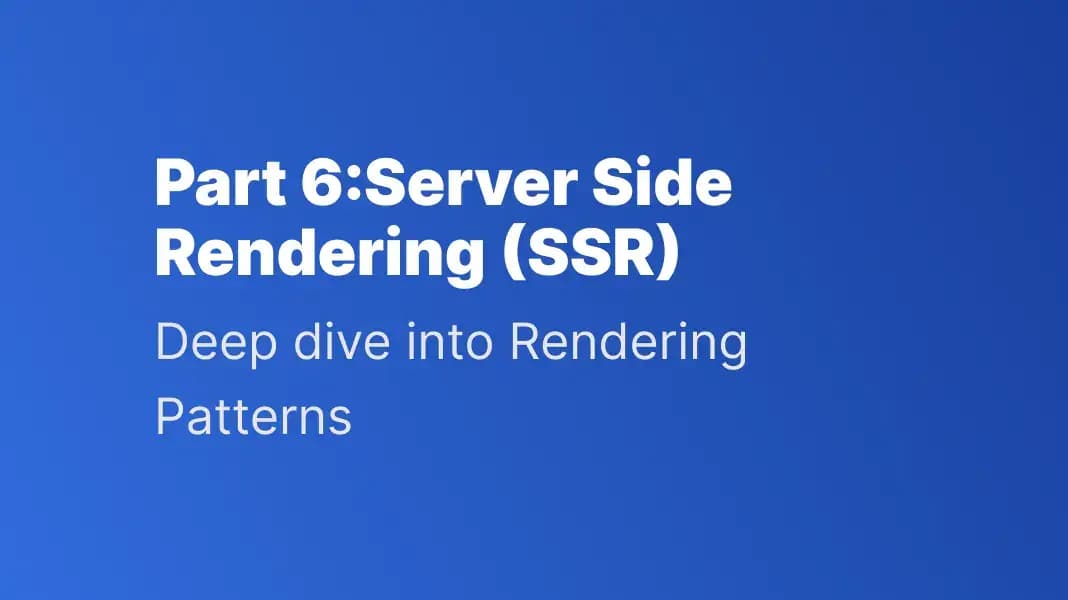user
Hey Chat, could you explain how Server Side Rendering(SSR) and Hydration work together in simple terms, assuming I have no idea about rendering patterns? 🤔

Hamza Miloud amar
June 22, 2024
4 min read

Welcome back! Previously, we discussed Static Site Generation. Today, we shift our focus to Server-Side Rendering (SSR), a technique where the server generates the HTML for a page on each request. SSR enhances performance and SEO by delivering fully rendered pages to the client, improving load times and user experience.
Web Development Group
Me , Server , Browser, CDN, Narrator
user
Hey Chat, could you explain how Server Side Rendering(SSR) and Hydration work together in simple terms, assuming I have no idea about rendering patterns? 🤔
narrator
Imagine you're at a fancy restaurant where the chef prepares each dish to order. When you place your order, the chef cooks the meal in the kitchen and delivers it to you, fresh and hot. You get to enjoy a dish that's made specifically for you at that moment. 🍽️
narrator
Once the dish is served, the waiter adds finishing touches like seasoning or garnishes right at your table to enhance the experience. This is like hydration – adding interactivity and dynamic elements to the freshly served content, making it more engaging and responsive for the user.
user
Mmm, that sounds interesting! Could you explain a real world example, showing the step by step process of how the server and browser work together to make this happen? 🤔
server
Certainly. In SSR with Hydration, my primary responsibility is to render the initial HTML of the web page on the server. This includes fetching necessary data, executing application logic, and generating the complete HTML structure, which is then sent to the Browser.
browser
Thank you, Server. my role is to receive that server-rendered HTML and immediately display it to the user. However, my work doesn't end there. I then utilize JavaScript to hydrate the static HTML. This involves attaching event listeners and adding application state, effectively transforming the static content into a fully interactive web application. 💻 You can check the last article about Hydration for more details.
user
Why would one choose to use SSR over other rendering methods?
server
It significantly improves the initial page load performance. Users can view the content almost instantly, as they receive a fully rendered page rather than waiting for JavaScript to execute and render the content on the client-side.
server
It's also SEO-friendly because search engines can easily crawl and index the server-rendered content, leading to better visibility in search results. 🏆
browser
Additionally, hydration allows us to maintain the benefits of client-side interactivity. By incrementally attaching JavaScript behavior to the existing HTML structure, we avoid the need for full page reloads, resulting in a seamless and responsive user experience.
user
Are there any potential drawbacks to this approach?
server
server
Increased server load, especially for complex pages or high traffic.
server
More complex development process compared to purely static sites or Client Side rendering.
server
Large JavaScript files can make it take longer for your website to become interactive.
user
Is there a way to reduce Time to Interactive (TTI) in this approach? It seems like there might be a delay before users can interact with the page fully.
browser
browser
Efficient Hydration: Techniques like partial hydration or progressive hydration can be employed. In our upcoming articles, we'll delve deeper into partial and progressive hydration.
user
Overall, it seems like SSR with Hydration presents a compelling solution for achieving fast initial page loads while maintaining dynamic functionality.
server
Precisely. By leveraging the strengths of both server-side and client-side rendering, SSR with Hydration provides a powerful approach for building high-performance, SEO-friendly web applications that deliver an excellent user experience.
me
Thanks for taking the time to read my article! I'd love to hear your feedback – any questions, suggestions, or different perspectives are welcome. Your input helps me improve and create even better content. Feel free to follow me and continue the conversation on 𝕏 to continue the discussion.
We hope you enjoyed learning about Server-Side Rendering. Join us next time as we explore Incremental Site Generation (ISG), a modern approach that combines the benefits of static and dynamic rendering for improved scalability. Goodbye for now, and see you in our next post on Incremental Site Generation!
Experienced Frontend Developer | Passionate about building elegant, accessible, and UX-friendly Design Systems with React | Skilled in React Next Remix | CSS enthusiast | Lover of Clean & Maintainable CSS | Always learning and growing.
Let's ConnectConnect With Me On Social Media
I appreciate your visit to my website. If you find my work interesting and would like to know more about me, please consider following me on social media. Thank you!
© 2026 Hamza Miloud Amar. All Rights Reserved
1460 Views